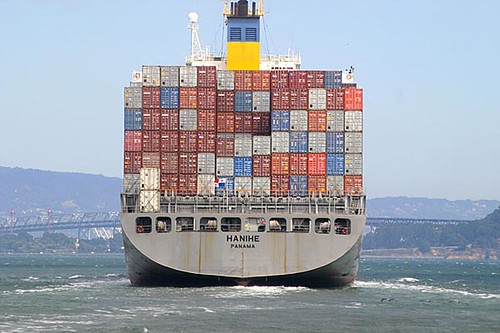How to Travel by Cargo Ship
Posted by Big Gav in shipping, transport
I've long been of the opinion that shipping is likely to remain the dominant form of freight transport, even in a world that is far past peak oil. The future of the airlines is a little less clear though, so there may be a case for the idea that we might see a rejuvenation of sea travel - one form of which is hitching a ride on a cargo ship, in which case this article might come in handy - How to Travel by Cargo Ship (via Idleworm).
I have always wanted a collection of brown leather trunks with brightly colored stickers from all the world’s corners. They remind me of travelers in the early 1900s who spent days on the ocean in order to reach their destinations. Back then, arriving at the destination was as much a part of the trip as the destination itself.
So when I needed to get from Guadeloupe in the Caribbean to France I asked myself, “is it still possible to travel by boat?” A few months later I was on a CMA-CGM cargo ship headed from Pointe-à-Pitre to Dunkerque.
My nine days on the Atlantic included gourmet French food, duty-free Porto and hours spent mesmerized by the blinking lights of the GPS. Yes, you can definitely still travel to many locations in the world by boat.
Here are some pointers for researching and planning your own adventure on the high seas:
1. What exactly is traveling by Cargo Ship?
Most of the major global shipping lines CMA-CGM, Canada Maritime, and Bank Line offer paying passengers to hop on one of their lines. As a paying passenger you are accommodated in guest cabins and have access to most areas of the ship.
Captains and crew spend a lot of time on the water, and they are usually happy to have a fresh face walking around their workplace, meaning that they may even invite you to eat with them, give you tours of the ship and maybe even have you over for an Officer’s happy hour.
2. Where can I go?
You can travel almost anywhere by cargo ship.
The global shipping industry is huge, and many ports like New York, Shanghai, Los Angeles, and Sydney welcome several ships everyday.
Just think: anywhere global commodities are shipped are places that you can disembark and spend time soaking up the local culture before re-boarding.
Shipping companies have certain lines covering specific routes, and many of them will allow you to buy a ticket for one of these lines and disembark and board as you please as long as there is a ship leaving on your chosen day.
This is often how round the world routes work: book your freighter ticket and then plan in a few weeks in every major port. With freighters, the possibilities for your adventure are almost endless. Just think: anywhere global commodities are shipped are places that you can disembark and spend time soaking up the local culture before re-boarding.
3. What will it cost?
A common misconception is that if you are willing to spend an extended amount of time on open water you can score an inexpensive mode of transportation to your next travel destination.
Although there are possibilities to work on boats, traveling as a passenger is in fact more expensive than your average airfare. But before you scoff at the price – plan on an average price of $80-140/day – consider this: your ticket pays for room, meals, and a plethora of experiences that cannot be had anywhere else.
4. Life on a ship
As a passenger you are surrounded by the everyday life of the vessel and her crew. Schedules revolve around mealtimes, which can be extravagant events depending on the chef.
If you are a gourmet traveler, consider traveling with one of the French companies which are known for their high quality cuisine and table wine. ...






